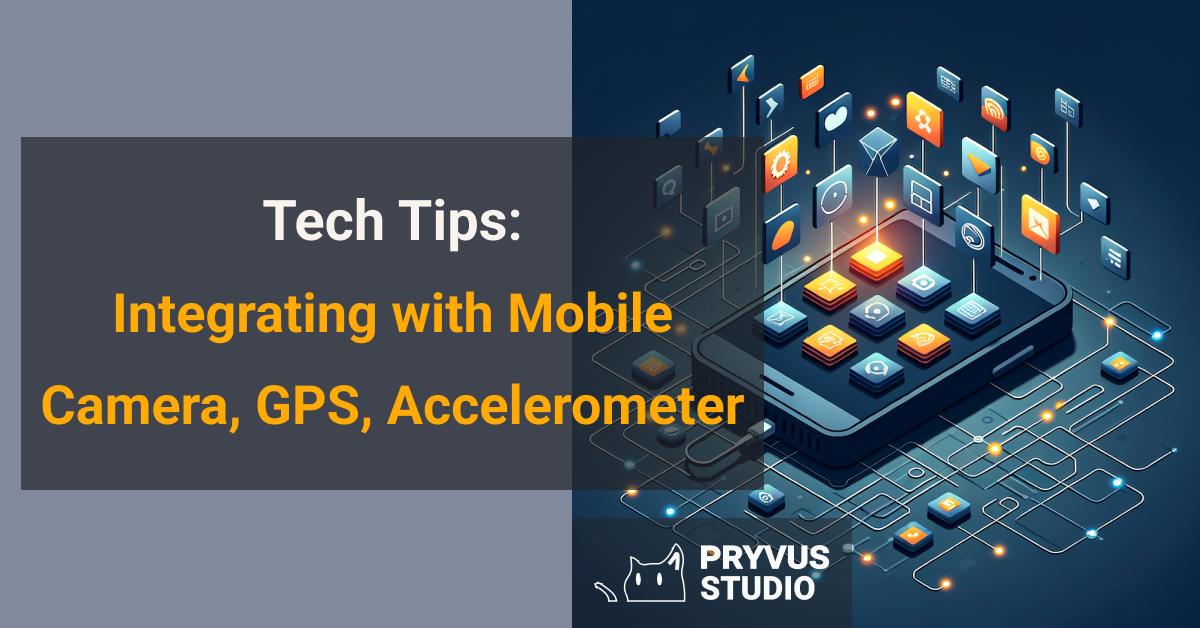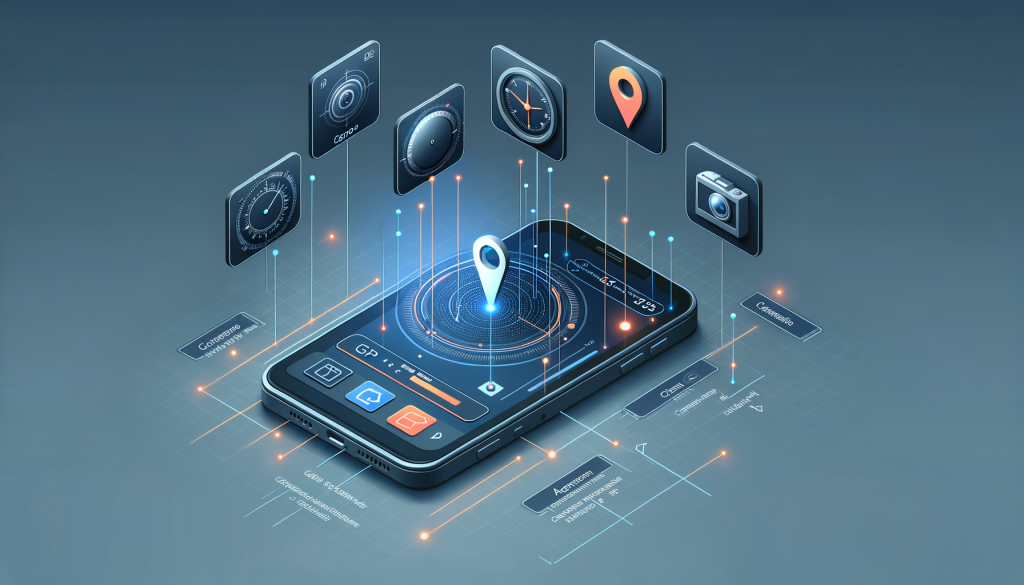Notice: Only variables should be passed by reference in /home/ploi/pryvus.com/public/wp-content/themes/pryvus/template-parts/content-post.php on line 12

Unlocking the potential of mobile device features can revolutionize mobile apps.
Integrating features like the camera, GPS, and accelerometer not only makes apps more interactive and engaging but also opens up new possibilities for user interaction and business opportunities. At Pryvus Studio, we specialize in harnessing these features to create custom, user-centric solutions that enhance the mobile experience.
In this article, you will learn:
- The importance of integrating mobile device features
- Design considerations for seamless app integration
- Best practices for security and privacy in app development
Unlocking the Potential of Mobile Device Features
Imagine a world where your mobile app does more than just sit on a screen. It interacts with the world around it, harnessing the power of the device’s camera, GPS, and accelerometer. Sounds pretty cool, right? Well, that’s exactly what we’re diving into today.
First off, why integrate these features? For starters, they can make apps more interactive and engaging. Think about apps that guide you through a city, measure your fitness levels, or even scan documents.
Integrating the Camera
Let’s kick things off with the camera. It’s not just for selfies! Apps can use it to scan QR codes, deposit checks, or even recognize faces. The trick is to make the process seamless for users. That means quick access and intuitive controls.
GPS Integration
Next up, GPS. This little gem can transform apps into personal navigators, fitness trackers, or even social tools that connect people in specific locations. But, it’s not just about slapping on a map and calling it a day. It’s about creating meaningful interactions based on location.
Accelerometer Insights
Last but not least, the accelerometer. This feature can turn a phone into a pedometer, a game controller, or a sleep monitor. The key is to use this data to enhance the app’s functionality, making it smarter and more responsive to the user’s needs.
At Pryvus Studio, we’ve harnessed these features to create innovative solutions for our clients. From streamlining business processes to unlocking new opportunities, we’ve seen firsthand the power of integrating mobile device features.
But, it’s not just about the tech. It’s about understanding your audience and how these features can improve their lives. That’s where the real magic happens.
So, ready to dive deeper? Let’s explore how to design these integrations with the user in mind.
Design Considerations for Mobile App Integration
When diving into the world of mobile app development, integrating device features such as the camera, GPS, and accelerometer requires careful planning. These features not only offer unique interactions but also pose design challenges. Understanding the nuances of each device feature is crucial for creating a seamless user experience.
The essence of mobile app integration lies in enhancing functionality while maintaining simplicity.

First and foremost, compatibility across different devices and operating systems is a key consideration. Developers must ensure that the app functions smoothly regardless of the user’s device. This might involve designing multiple versions of a feature or implementing fallback options for devices that lack certain capabilities.
Another crucial aspect is user interface (UI) design. Integrating complex device features should not complicate the user experience. Instead, UI should guide users through the app, making the use of features like the camera and GPS intuitive. For example, when integrating the camera, consider how users will access it. Will it be a central feature or an optional one? Such decisions impact the overall design and user flow.
Privacy and security also play a significant role in design considerations. With features like GPS and the camera, apps often require access to sensitive information. Transparent permission requests and clear explanations of how data will be used can help build trust with users. Additionally, implementing robust security measures to protect this data is non-negotiable.
Finally, testing is an integral part of the design process. Rigorous testing across various devices ensures that integration issues are identified and resolved early. This includes testing for performance, usability, and security vulnerabilities.
In conclusion, integrating mobile device features requires a balance between innovation and user-centric design. By focusing on compatibility, UI design, privacy, and thorough testing, developers can create apps that not only leverage device capabilities but also provide a seamless and secure user experience.
Enhancing User Experience with Device Features
When it comes to mobile app development, integrating native device features like the camera, GPS, and accelerometer can significantly enhance the user experience. These features, when used creatively, can make apps more interactive, personalized, and engaging. For example, a fitness app can use the accelerometer to track a user’s steps and the GPS to map their running route, providing a comprehensive workout log.
Integrating mobile device features enhances app interactivity, personalization, and user engagement.
But it’s not just about adding these features; it’s about integrating them in a way that feels seamless and intuitive. User interface design plays a crucial role here. A well-designed app anticipates the user’s needs and makes the most of the device’s capabilities without overwhelming the user. For instance, camera integration in social media apps has enabled features like face filters and QR code scanning, making the user experience more fun and interactive.
Key Considerations for a Seamless Integration
- User Consent: Always request permission before accessing a user’s camera, GPS, or other features.
- Privacy and Security: Implement strong data protection measures to secure users’ personal information.
- Device Compatibility: Ensure your app functions smoothly across different devices and operating systems.
- Intuitive Design: Design interfaces that make it easy for users to leverage these features without confusion.
Finally, testing is essential. Rigorous testing across various devices ensures that your app not only integrates these features well but also maintains high performance and security standards. Remember, the goal is to enhance the user experience, not complicate it. By focusing on seamless integration, privacy, and intuitive design, developers can unlock the full potential of mobile device features to create truly engaging and personalized app experiences.
Security and Privacy: Best Practices
When integrating mobile device features like the camera, GPS, and accelerometer into apps, security and privacy can’t be an afterthought. These features, while unlocking immense potential, also open the door to potential security vulnerabilities and privacy concerns. It’s crucial to implement best practices from the start to protect user data and maintain trust.
Ensuring user data security and privacy is paramount when integrating mobile device features into apps.

Encrypt Sensitive Data: Any data collected through mobile device features should be encrypted both in transit and at rest. This prevents unauthorized access to personal information, even if a breach occurs.
User Consent and Transparency: Apps must explicitly request permission from users before accessing their camera, GPS, or accelerometer. Clearly explain why these permissions are needed and how the data will be used, fostering transparency and trust.
Regular Security Audits: Conducting regular security audits can help identify and rectify vulnerabilities. Incorporate security testing into the development lifecycle to ensure that privacy controls and security measures remain effective over time.
Limit Data Collection: Only collect data that is essential for the app’s functionality. Minimizing the amount of collected data reduces the risk of sensitive information being compromised.
Implementing these best practices is not just about protecting users; it’s about building a secure foundation for your app’s success. At Pryvus Studio, we understand the intricacies of integrating these mobile features while ensuring the highest standards of security and privacy.
Bringing It All Together
Unlocking the potential of mobile device features isn’t just about adding bells and whistles to an app; it’s about creating a more engaging, intuitive, and secure user experience. By integrating features like the camera, GPS, and accelerometer, apps can become more than just tools; they transform into interactive platforms that enhance our daily lives.
At Pryvus Studio, we understand the importance of:
- Seamless integration for a smooth user experience
- Intuitive design that makes new features easy to use
- Strong privacy measures to protect user information
By focusing on these key areas, we help businesses unlock new opportunities and streamline processes. Our commitment to security and privacy ensures that every app we develop not only meets but exceeds user expectations.
But what does this mean for you? Well, if you’re looking to enhance your app or create a new one, you’re in the right place. Pryvus Studio is here to turn your ideas into reality, leveraging the latest mobile device features to deliver custom solutions that stand out in a crowded market.
Ready to unlock the full potential of your mobile app? Let’s chat! Reach out to us at Pryvus Studio, and let’s explore the possibilities together.


